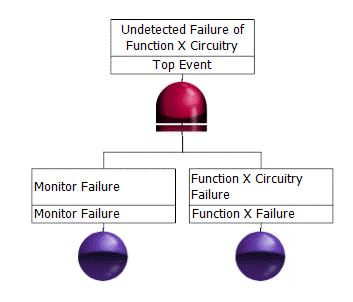Sequencing AND Gate (SAE Fault Trees Only)
The sequencing AND gate is a special gate that can be inserted only in SAE fault trees. SAE ARP4754A and ARP4761 provide guidelines and methods for conducting safety assessments on civil airborne systems and equipment. For more information, see Performing SAE ARP4754A and ARP4761 Analysis.

You use the sequencing AND gate to indicate that the output occurs if and only if all input events occur in a specific order. This gate can be viewed as a simplified and approximate representation of a priority AND gate, which is a dynamic gate that can be inserted only in time dependent trees. For more information, see Priority AND Gate.
In an SAE tree, the inputs for the sequencing AND gate are the failure order dependent inputs (events or gates). To account for the failure order-dependent events, SAE ARP4761 indicates that a factor may be incorporated into the tree to make the calculated probabilities less conservative. This factor is known as the required order factor or sequencing factor.
The required order factor is equivalent to the probability of inputs failing in a certain sequence given that all inputs have occurred. Therefore, once the required input factor is known, you can calculate the probability of inputs failing in a certain sequence as the product of the required order factor and the probability of occurrence of all events.
For an accurate evaluation of the required order factor, the probability of each failure sequence should be calculated, which is also the case with the priority AND gate. However, for small failure rates (λ) and/or flight times (t), required order factor calculations can be simplified. For example, for a small λt value, the probability of the two events occurring in either order (given that both fail) is approximately ½ of the total probability; therefore, the rate of failure for each order is ½.
In general, if there are n events in a sequencing AND gate, there are n! possible orders in which they could fail. If only k of these possible orders lead to the top event (or the gate output), then the required order factor is equal to k/n!. This approximation produces accurate results when the failure rates of all inputs are equal. However, if events have different failure rates and exposure times, then this approximation is only valid when (λ1+ λ2)Tmax is less than 0.2. From the required order factor formula, it can be observed that the k value must be less than or equal to n!.
To calculate the required order factor, the number of valid sequences (k) should be specified. However, in certain cases, you might need to calculate the required order factor using different methods, such as Markov chains. Similarly, when complex sequence ordering logics are present due to multiple levels of sequencing logic, such as in Figure D16 in SAE ARP4761, you might want to enter the value for the required order factor directly.
The simplified approach suggested in SAE ARP4761 makes the sequencing AND gate logically equivalent to an AND gate with an additional event that represents the required order factor value for the conditional occurrence of the valid sequences. For example, in Appendix D of SAE ARP4761, Figure D5 contains four events. The last event represents the required order factor for the remaining order-dependent events. In the FTA module, you can model this using a sequencing AND gate with three events. The required order factor for the gate input is 1/6, or alternatively, the number of valid sequences (k) is 1.
The output of a sequencing AND gate can be the top event or an intermediate event. The inputs can be basic events or outputs of any gate that are available in SAE trees. You can rearrange items that enter sequencing AND gates by clicking and dragging them to new locations. The sequencing AND gate also supports a single input. When only a single input exists, the occurrence of that input will trigger the event.
Summary of Logic: In addition to the logical event representing the valid sequences, all events must be TRUE for the output to be TRUE.
A truth table for a sequencing AND gate follows. The Boolean equation for a sequencing AND gate is T = A * B * S, where input events A and B and the logical event S, which represents the valid sequences that must occur.
Input 1 A | Input 2 B | Valid Sequence | Output |
|---|---|---|---|
T | T | T | T |
T | T | F | F |
T | F | T | F |
T | F | F | F |
F | T | T | F |
F | T | F | F |
F | F | T | F |
F | F | F | F |
Example
A monitor is used to detect failures of functional circuitry that can cause the top event to occur. If the monitor fails first, the failure might remain latent until the monitor is next checked. If the function X circuitry fails first, the top level event does not occur because the monitor annunciates the failure.

Because a failure dependency associated with a monitor is a common scenario, this failure dependency is directly supported. In the FTA module, you can model the above scenario using only one event, which represents the function X circuitry failure and then specify the failure behavior of the monitor. In addition to using sequencing AND gates for monitor failures, you can use them to represent other order-dependent events such as switch failures and backup unit failures.